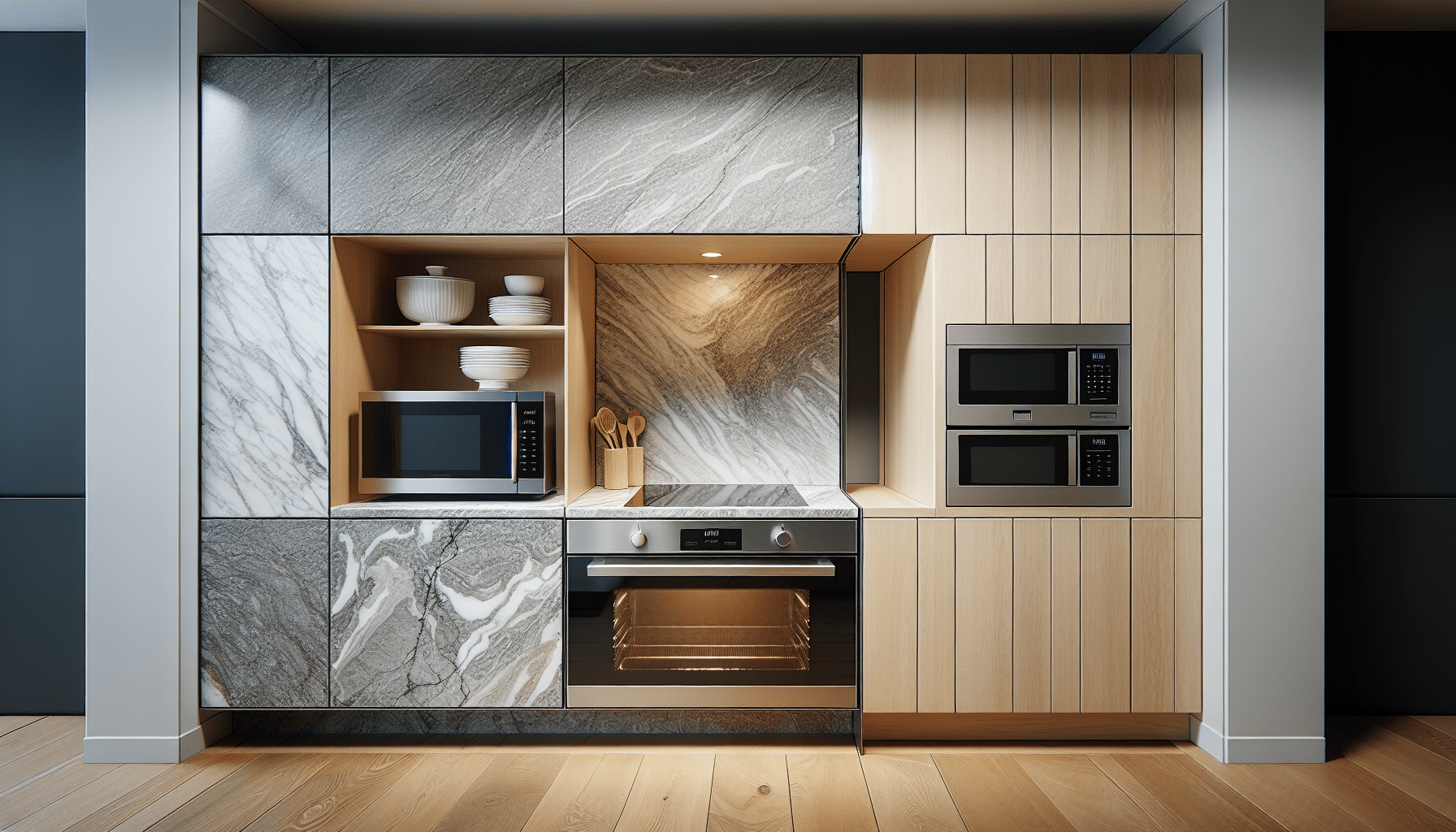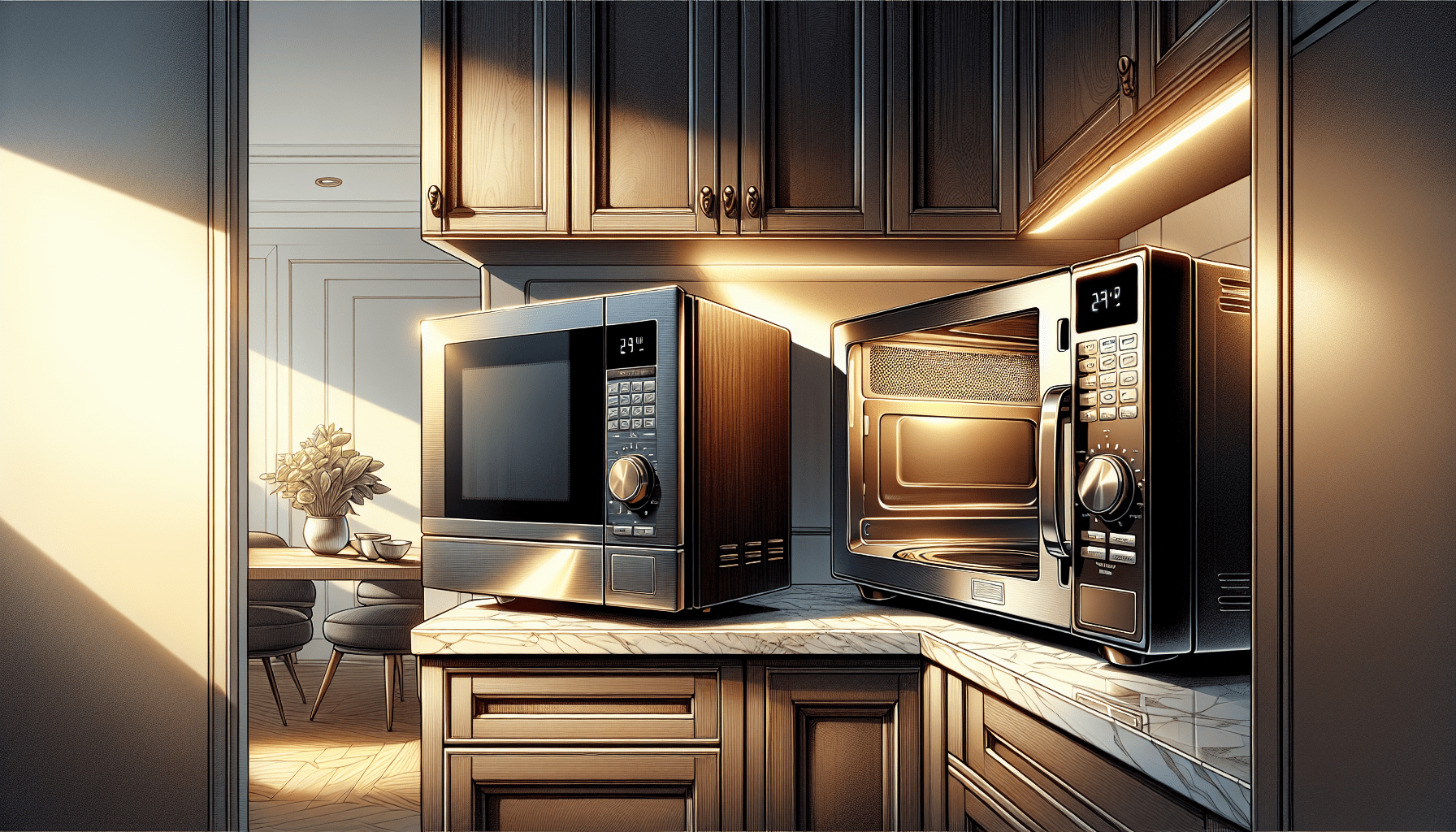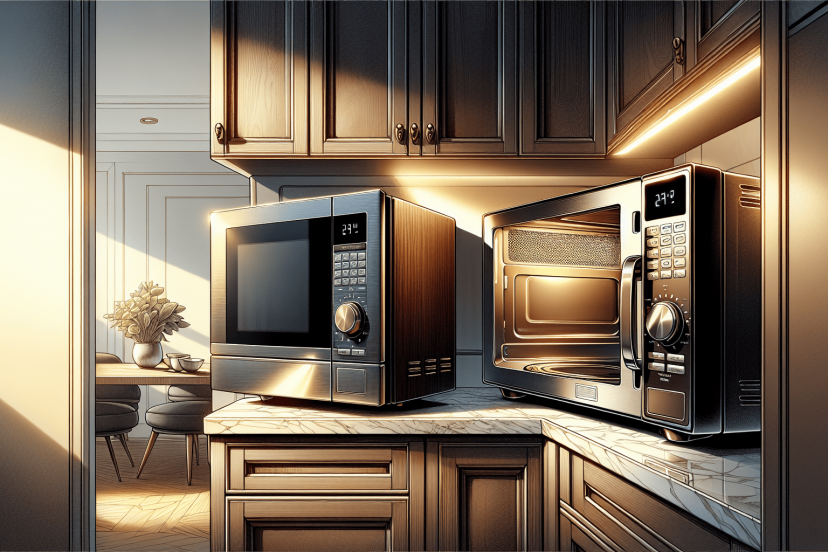What Is The Difference Between A Countertop And Built In Microwave?
When it comes to microwaves, the options can seem overwhelming. But fear not, because we have all the information you need to make the right choice! In this article, we will explore the difference between a countertop and built-in microwave. From their placement in the kitchen to their unique features, we’ll help you understand which option is best for your needs. So, sit back, relax, and prepare to become a microwave expert!

Size and Design
Countertop Microwaves
Countertop microwaves are designed to sit on a kitchen counter or any flat surface, hence their name. They are typically compact and lightweight, making them easy to move around if needed. These microwaves come in a variety of sizes, ranging from small models perfect for dorm rooms or small apartments, to larger models that can accommodate larger dishes or cookware. The design of countertop microwaves often features a door on the front that opens downwards, revealing the interior cooking space.
Built-in Microwaves
On the other hand, built-in microwaves are specifically designed to be integrated into kitchen cabinetry or walls. These microwaves are installed at a higher level, usually at eye-level or above the oven, and are built into a designated space. Built-in microwaves offer a sleek and seamless appearance as they are seamlessly integrated into the kitchen design. They are available in various sizes to fit different kitchen layouts and preferences, and they often come with trim kits that allow for a seamless installation.
Installation
Countertop Microwaves
Installing a countertop microwave is extremely easy and straightforward. All you have to do is find a suitable spot on your kitchen counter, plug it into an electrical outlet, and you’re good to go. No additional installation or modifications are required, making it a convenient choice for those who want a hassle-free setup.
Built-in Microwaves
Installing a built-in microwave, on the other hand, requires a bit more effort and planning. It often involves hiring a professional or a knowledgeable individual to ensure proper installation. Built-in microwaves need to be mounted into a designated space in the cabinetry or wall, which may require cutting or modifying the existing structure. Additionally, electrical and ventilation considerations need to be taken into account during the installation process.
Space Requirement
Countertop Microwaves
One of the advantages of countertop microwaves is that they are not space-restrictive. As long as you have a flat surface available, you can place the microwave anywhere you like. This flexibility allows you to move the microwave around your kitchen and even bring it along if you move houses. Countertop microwaves are an excellent choice for those with limited kitchen space or for renters who may not have the freedom to make permanent changes to the kitchen.
Built-in Microwaves
Built-in microwaves, on the other hand, require dedicated space within your cabinetry or walls. This means that you need to plan and design your kitchen layout accordingly to accommodate the microwave. The designated space should not only fit the specific dimensions of the microwave but also take into account proper ventilation and electrical requirements. While built-in microwaves offer a sleek and integrated look, they require more thought and consideration when it comes to space planning.
Functionality
Countertop Microwaves
Countertop microwaves offer a wide range of functions and features to make your cooking experience easier and more convenient. Most countertop microwaves come with programmable settings, such as defrost, popcorn, or sensor cooking options, which simplify the process of cooking various types of food. Additionally, they often have a turntable that rotates the food during cooking, ensuring even heat distribution. Some countertop microwaves even come with additional features like grilling or convection settings, allowing you to expand your cooking capabilities.
Built-in Microwaves
Similar to countertop microwaves, built-in microwaves also offer a variety of functions and features to enhance your cooking experience. These microwaves often come with advanced settings, such as multiple power levels and precise cooking modes, which allow for more precise control over your cooking. Many built-in microwaves also include sensor cooking technology, which automatically adjusts the cooking time and power level based on the detected humidity and temperature, ensuring optimal results. Overall, built-in microwaves are designed to provide a high level of functionality and versatility in the kitchen.

Power and Performance
Countertop Microwaves
Countertop microwaves typically come in a range of power levels, starting from around 600 watts and going up to 1200 watts or more. Higher wattage microwaves tend to offer faster and more efficient cooking, as they can generate more heat. However, it’s important to note that the power and performance of a countertop microwave can vary depending on the brand and model. Some countertop microwaves may prioritize convenience and compactness over raw power, while others may focus on delivering high-performance cooking capabilities.
Built-in Microwaves
Built-in microwaves, like countertop microwaves, also come in a range of power levels to cater to different cooking needs. However, built-in microwaves often have higher power outputs compared to countertop models, ranging from 900 watts to 1500 watts or more. The higher power output allows for faster and more efficient cooking, making built-in microwaves ideal for those who frequently use their microwaves for various cooking tasks. Additionally, built-in microwaves often have advanced heating technology, such as inverter technology, which provides more even and precise cooking results.
Price
Countertop Microwaves
When it comes to price, countertop microwaves are generally more affordable compared to built-in microwaves. Countertop microwaves come in a wide range of price points, catering to different budgets and preferences. The price of a countertop microwave can vary depending on factors such as brand, size, power, and additional features. However, even at the higher end of the price range, countertop microwaves are generally more budget-friendly compared to their built-in counterparts.
Built-in Microwaves
Built-in microwaves, being specifically designed for integration into cabinetry or walls, tend to be more expensive compared to countertop microwaves. The price of a built-in microwave can vary depending on factors such as brand, size, power, and additional features. Additionally, the cost of installation and any necessary modifications to the kitchen structure should also be taken into account. While built-in microwaves may have a higher price tag, they offer a seamless and integrated look that can enhance the overall aesthetic of your kitchen.
Flexibility
Countertop Microwaves
Countertop microwaves offer a high level of flexibility and convenience. They are portable and lightweight, allowing you to easily move them around your kitchen or even take them with you if needed. This flexibility is particularly beneficial for those who have limited kitchen space, frequently change their living arrangements, or enjoy outdoor cooking. Countertop microwaves can be placed wherever you have a flat surface, giving you the freedom to adapt and adjust your kitchen setup as necessary.
Built-in Microwaves
Built-in microwaves, due to their integrated nature, offer less flexibility compared to countertop microwaves. Once installed, they become a permanent fixture in your kitchen, making it difficult to relocate them. Built-in microwaves are best suited for those who have a fixed kitchen layout and are not planning to change their setup frequently. However, it’s worth noting that built-in microwaves offer the advantage of freeing up valuable countertop space, allowing for a cleaner and more streamlined kitchen appearance.
Aesthetics
Countertop Microwaves
Countertop microwaves come in a wide range of designs and finishes, allowing you to choose a model that complements your kitchen decor. Whether you prefer a sleek stainless steel look, a colorful retro design, or a more traditional aesthetic, there is a countertop microwave to suit your style. While countertop microwaves may take up some counter space, they can also add a visual element to your kitchen, serving as a functional and decorative appliance.
Built-in Microwaves
When it comes to aesthetics, built-in microwaves excel in providing a seamless and integrated look in the kitchen. These microwaves are designed to blend seamlessly with the surrounding cabinetry or walls, creating a cohesive and polished appearance. Built-in microwaves often come with trim kits that ensure a smooth transition between the microwave and the surrounding structure. The result is a kitchen that exudes a high-end, custom look, showcasing a unified design aesthetic.
Maintenance and Cleaning
Countertop Microwaves
Maintaining and cleaning a countertop microwave is relatively easy. The exterior can be wiped down with a damp cloth and mild detergent, while the interior can be cleaned by using a microwave-safe cleaning solution or a mixture of vinegar and water. Many countertop microwaves also come with a removable turntable and a dishwasher-safe interior, making it convenient to clean any spills or food splatters. Regular cleaning and maintenance will help ensure the longevity and optimal performance of your countertop microwave.
Built-in Microwaves
Cleaning and maintaining a built-in microwave can be slightly more challenging compared to countertop models due to its integrated nature. The exterior of a built-in microwave can be cleaned in a similar manner to a countertop microwave. However, cleaning the interior may require extra care and attention, as spills and food splatters can accumulate in hard-to-reach areas. It’s important to consult the manufacturer’s instructions for specific cleaning recommendations and avoid using harsh chemicals or abrasive materials that could damage the microwave or surrounding structure.
Conclusion
In conclusion, both countertop and built-in microwaves offer their respective advantages and considerations. Countertop microwaves provide flexibility, easy installation, and a range of sizes and designs to choose from. They are suitable for those with limited space, renters, or those who frequently move. On the other hand, built-in microwaves offer a seamless and integrated look, higher power and performance, and a more polished aesthetic. They require careful planning and installation but can enhance the overall design of your kitchen. Ultimately, the choice between a countertop and built-in microwave depends on your specific needs, preferences, and kitchen layout.




